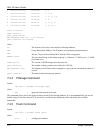
AES-100 User’s Guide
Bridge Commands 7-7
This example sets the allowed outgoing bridge ports of port 2 (ADSL port 1) to port 1 (Ethernet port) and port 3
(ADSL port 2). The allowed outgoing bridge ports of port 3 (ADSL port 2) are set to port 1 (Ethernet port) and
port 2 (ADSL port1). This way ADSL ports 2 and 3 can communicate with each other and the Ethernet port. You
can see the effects of this example by using the following command:
192.168.1.1 bridge> portfilter
Port 1 (ethernet): all
Port 2 (adsl1): 1 3
Port 3 (adsl2): 1 2
Port 4 (adsl3): 1
Port 5 (adsl4): 1
Port 6 (adsl5): 1
Port 7 (adsl6): 1
Port 8 (adsl7): 1
Port 9 (adsl8): 1
The following figures illustrate the above example. Notice that ports 2 (ADSL port 1) and 3 (ADSL port 2) are
able to communicate with each other, as well as with the Ethernet. All of the other ports will only be able to
communicate with the Ethernet port.
The following figure illustrates the
192.168.1.1 bridge> portfilter 2 1 3
command line. Port 2 (ADSL port 1) is able to send to both the Ethernet port and port 3 (ADSL port 2).
Figure 7-2 Example of Modified VLAN Port 2
The following figure illustrates the
192.168.1.1 bridge> portfilter 3 1 2
command line.
Port 3 (ADSL port 2) is able to send to both the Ethernet port and port 2 (ADSL port 1).


















